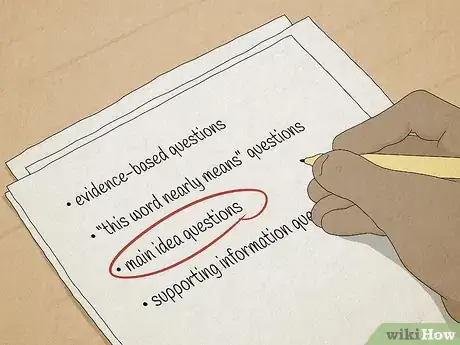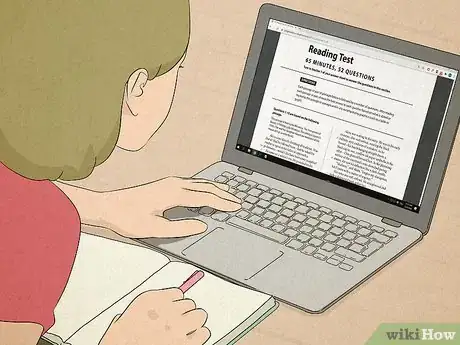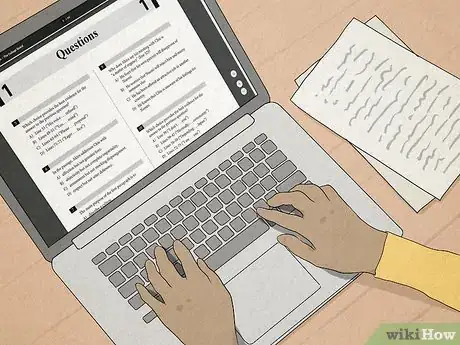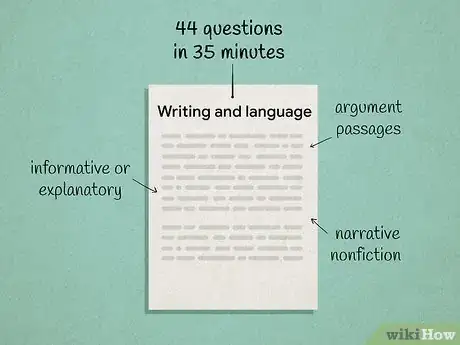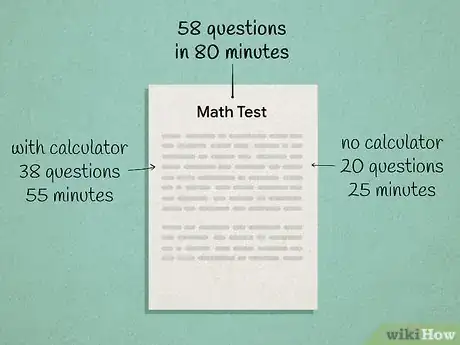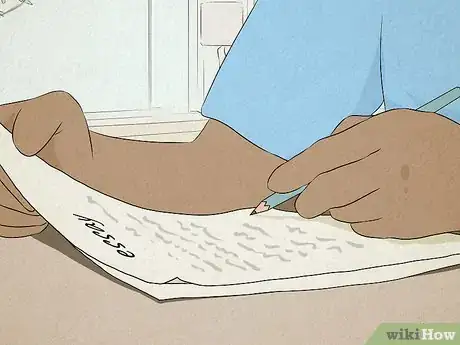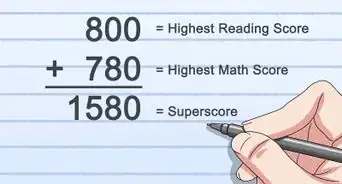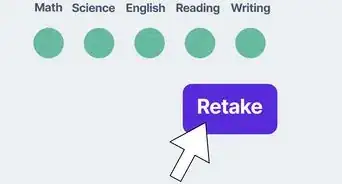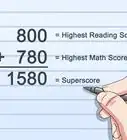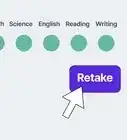This article was co-authored by Arash Fayz and by wikiHow staff writer, Eric McClure. Arash Fayz is the Co-Founder and Executive Director of LA Tutors 123, an academic consulting and private tutoring company based in Los Angeles, California. Arash has over 10 years of educational consulting experience, managing the tutoring of students of all ages, abilities, and backgrounds to score higher on standardized tests and gain admission to their target schools. He has a BA in Applied Mathematics and Computer Science from the University of California, Los Angeles.
There are 18 references cited in this article, which can be found at the bottom of the page.
This article has been viewed 64,229 times.
The SAT (Scholastic Aptitude Test) can be seriously intimidating. You may have even heard from your peers and teachers that the test will determine your future. Relax! The SAT isn't the most important thing you'll ever have to do, so long as you’re willing to put in a little preparation. The best way to prepare for the SAT is just to get reps in. Like shooting a basketball or lifting weights, you’re only going to improve with practice. Complete as many of the free College Board practice tests as you reasonably can. It also helps to remember that you can always retake the test if you don’t do well on it the first time.
Steps
Reading
-
1Reading test format: 52 questions in 65 minutes. This may sound like a lot of time, but you do have to read 5 passages to complete these questions. The passages aren’t super long—most are under a full page—but knowing the type of texts you’re going to run into will help you prepare. There will always be:[1]
- 1 passage from a classic work of literature.
- 1 passage from a founding US document.
- 1 passage about a social science.
- 2 passages about science.
-
2Identify the types of questions you struggle with in practice exams. There are only a handful of different question formats in the reading section. Do a practice exam and check your work. Analyze the questions you’re getting wrong to see if there’s a specific type of question you can improve on.[2] Common question categories include:
- Evidence-based questions (supporting claims with evidence).
- “This word nearly means” questions (diction, synonyms, and clarity).
- Main idea questions (summary, theme, and author intention).
- Supporting information questions (citing lines in the text).
Advertisement -
3Work on reading comprehension by tackling challenging texts. In the months leading up to the SAT, get your hands on articles, books, and practice exams that are at or above your reading level. The more reading you can do in your spare time, the better you’ll get at analyzing complex sentences, extracting key information, and fluently processing tough material.[3]
- Review SAT-level vocabulary lists. There are certain vocab terms that will show up often on the exam. Reviewing these lists are a great way to make sure you aren’t caught off guard by any confusing words.
- Try summarizing every text you read out loud to yourself when you’re done. This is a great way to practice identifying the main idea. There are typically 1-2 questions associated with every passage that ask you to analyze the main idea, so this is a great way to practice.
- Read texts in the same category as the SAT reading section. Read medical articles, travel magazines, breaking news stories, historical documents, and old books. They may not be your favorite genres, but the practice will pay off!
EXPERT TIPAs early as middle school, students can read newspaper articles and books to improve their reading comprehension.
Arash Fayz is the Co-Founder and Executive Director of LA Tutors 123, an academic consulting and private tutoring company based in Los Angeles, California. Arash has over 10 years of educational consulting experience, managing the tutoring of students of all ages, abilities, and backgrounds to score higher on standardized tests and gain admission to their target schools. He has a BA in Applied Mathematics and Computer Science from the University of California, Los Angeles.
Arash Fayz
Test Prep Tutor Arash Fayz
Arash Fayz
Test Prep Tutor -
4Read passages from sample tests to get used to them. The absolute best way to practice for any section of the SAT is to complete the practice tests. This is especially true for the reading section, since the categories for each passage are identical across tests. Even if you don’t have the time to answer all of the questions, reading sample texts while you’re riding the bus or eating a late-night snack will really add up.[4]
- College Board, the company that publishes and administers the SAT, releases 10 practice exams every year. Start with those and work your way back through the previous year’s tests over time.
- Since the time you spend reading is time you can't use to answer questions, you'll want to get through the passages reasonably fast. If you're not the quickest reader, try to practice improving your reading speed by identifying the main concepts in each paragraph.
-
5Check the questions first to keep key info in mind as you read. Some students have an easier time with the reading section when they scan the questions first. To do this, check each question stem and ignore any questions that include line numbers (since these questions are already telling you where to look). For the 3-4 questions that don’t have line numbers, you know to pay special attention and take notes when those questions come up as you read.[5]
- For example, if the question is “Why doesn’t Rey seem to trust her father?” you know you need to pay extra attention to the sections of the text where Rey is talking about her father.
- On the other hand, a question like, “In line 14, the word ‘expressive’ most nearly means…” tells you exactly where to look in the text. No need to keep an eye out for an answer if you’ll know where to look!
-
6Rule out incorrect options, even if you think you know the answer. In the reading section, the SAT can be a little deceptive. Multiple answers may seem very similar, so don’t lock in the first answer that sounds right. Instead, check every possible answer to see if there’s something you’re overlooking. This is a great way to avoid jumping the gun and getting easy questions wrong.[6]
- For example, let’s say there’s a question like, “Why doesn’t Frank like his teacher?” and the first option is, “He doesn’t like her teaching style.” That may jump out immediately as the right answer. But another option may read, “He dislikes the way she asks questions in class” which may be a more accurate option depending on the text.
Writing and Language
-
1Writing and language test format: 44 questions in 35 minutes. You don’t have nearly as much to read compared to the other English section here. The passages can vary in subject matter, although they tend to include a nonfiction story, a historical text, and a passage about science.[7]
- While reading a lot will help you out with the reading section, writing a lot won’t necessarily help you with the writing and language section. Think of this section more like an editing test where you goal is to improve the writing and catch grammar mistakes.
-
2Check your work in writing and language to find room for improvement. Like the reading section, writing and language questions fall into 5 categories. Checking your work will help you see if there’s a type of question you need to keep working on. The questions in this section are divided as follows:[8]
- Command of evidence (supporting claims about the text).
- Words in context (fluidity of language, clarity, and diction).
- Improve the passage (language skills and tone).
- Expression of ideas (syntax and editing).
- English conventions and grammar (punctuation, agreement, and capitalization).
-
3Review punctuation rules and phrases to sharpen your grammar skills. A large chunk of the conventions and grammar questions have to do with punctuation. Go through your old grammar notes and ask your teacher any clarifying questions you may have about how semicolons work, or what the rules for em dashes are. Online grammar quizzes, YouTube tutorials, and reviewing your English notes are all great ways to improve here![9]
- Be sure to review the rules for possessive apostrophes and the letter “s.” You’ll run into a few questions about names that end in “s” and apostrophes.
- There are typically 1-2 questions about who vs. whom. If you can remember the rules for these (who is a subject, whom is an object), these are typically free questions.
- Restrictive and nonrestrictive phrases are a big component of this section. Brush up on the rules surrounding commas and optional phrases to avoid getting these questions wrong.
-
4Answer the questions as you read to get into a good flow. Unlike the reading section where you should read the entire passage before you answer a question, you’re probably going to save time by answering each question as you read. Whenever you see underlined information, read through to the end of the sentence and then answer the question.[10]
- For command of evidence and context questions, read ahead a few sentences before answering. The surrounding sentences can give you a hint on whether the sentence needs to be changed or not.
- Unlike the ACT, the SAT doesn’t ask any overarching questions about the text as a whole in this section. You will not be asked to identify the theme or main idea, so don’t worry if you aren’t following the passage perfectly.
-
5Lean toward the shorter, simpler options when weighing answers. Whenever you find yourself split between 2-3 possible answers, assume that the shorter, cleaner answer is more likely to be correct. This isn’t always going to be the case, but the SAT writing and language section tends to prioritize an efficient and succinct type of writing.[11]
- For example, let’s say the underlined portion of the sentence reads “but in 1976, journalist and author Ed Smith wrote his magnum opus.” If you’re choosing between replacing it with “but in 1976, Ed Smith wrote his massive magnum opus” and “Ed Smith wrote his magnum opus in 1976,” the latter is probably the answer because it streamlines the sentence.
Math
-
1Math test format: 58 questions in 80 minutes. The math portion of the SAT is divided into two sections, but they aren’t really all that different.[12] Calculators are not allowed on the first section, while the second section lets you use a calculator[13]
- You will be given a reference chart with equations for both sections, so don’t worry about memorizing formulas.
- Most of the math section is multiple-choice, but there are a handful of open-ended questions you’ll have to answer in the calculator section.
-
2Complete practice tests to spot potential gaps in your knowledge. Use the College Board practice exams to test your math skills. Even if it’s just one question a day, getting used to the wording and format of the math section will help dramatically. This will also help you figure out if you need to review any specific concepts.[14] Questions in the math section cover:
- Algebra (linear equations, variables, and graphs).
- Data analysis (quantitative data, probability, and reading charts).
- Advanced math (equivalent expressions, quadratic equations, and functions).
- Geometry and trigonometry.
-
3Practice answering word problems and extracting the key information. Start by breaking word problems down, and get in the habit of underlining the essential information as it corresponds to the question. A lot of the word problems can trip you up with unnecessary information, so work slowly and read carefully![15]
- Ignoring irrelevant information is essential. Get in the habit of reading the question carefully to determine what info you actually need to answer the question.[16]
- When it comes to math problems, a single missed word can lead you to an incorrect answer. Be sure you understand what each question is asking you to do before you answer.
- Word problems and data analysis questions on the SAT will often judge your ability to interpret ratios, proportions, and data sets.
-
4Refresh your algebra skills by practicing expressions and finding variables. The vast majority of the questions in both math sections are on algebra.[17] Review your old algebra notes and practice defining variables, analyzing equations, and charting graphs with worksheets or practice games. If possible, swing by your algebra teacher’s classroom after school and ask for additional help if you need it.[18]
- Go through your algebra textbook and try your hand at various problems in each section. This is a great way to see if you need help in any particular area.
- There are tons of online quizzes and games out there for practicing algebra. If you’ve got a few hours to kill, try your hand at some quick online questions.
-
5Get some geometry practice with circles and angles to prep for trigonometry. There are always a handful of questions that involve calculating angles, finding areas, and using trigonometry ratios (SOH CAH TOA). Brush up on your angle charting and trig formulas to make sure you’re ready for all of the geometry and trigonometry questions.[19]
- Ask the math teachers at your school for geometry and trigonometry worksheets so you can practice on your own time.
- The old SAT included a lot more geometry than trigonometry. This balance has shifted with the new SAT, so make sure you’re only using practice tests from the past 2-3 years to avoid over prepping for geometry questions.[20]
Test-Taking Strategies
-
1Read the directions for every section and question carefully. One of the common mistakes that students make on the SAT is that they get into a flow with the material and they end up missing key words and instructions. Take your time when reading the instructions and don’t assume you know what the question is asking. Skipping a single word can dramatically change the meaning of a question so take it slow![21]
- In the reading section, that little bit of text at the beginning of each passage is worth reading. Knowing the author’s name and the year a text was published can really help you interpret what’s going on.
-
2Skip difficult questions and return to them later if you’re behind. If you run into a question that’s really hard for you, circle the number or make a note and skip it. It’s better to leave 2 hard questions for the end than it is to end up 10 minutes behind with a bunch of questions unanswered. Once you get to the end of the section, go back and answer all of the hard questions you skipped.[22]
- There’s no value in wasting time on a question that totally confuses you. You’re more likely to get these questions wrong, so it’s better to move on to other questions where you’ll have a better chance of getting it right.
- Don’t beat yourself up over falling behind. A lot of students get anxiety that they’re on a timer. Try not to pay too much attention to the clock. It’s important to know if you’re behind, but if you’re losing focus on the question because you’re worrying about the clock, it isn’t a productive exercise.
-
3Guess if you’re absolutely lost or running out of time. If you find yourself completely bewildered by a question or you’re down to your last few minutes and you have unanswered questions, just throw an answer out there. The older version of the SAT penalized you for getting a question wrong, but that’s no longer the case. You’re better off guessing than you are leaving any answers blank.[23]
- If you can, eliminate any obviously wrong answers before you fill in any answer bubbles. It’s always better to make an educated guess than a random one.
Study Tips and Resources
-
1Start studying for the SAT at least 6 months before the exam. The longer you have to familiarize yourself with the test, the better you’re going to do. Roughly 6 months before the test, start studying regularly every week. You could study 30 minutes every 2-3 days, or dedicate 1-2 hours a week to practicing. With 3 months left, start targeting the areas you need to improve. When you’re 1 month out, practice taking entire practice tests and drill yourself with questions you’ve been struggling with.[24]
- For example, you might start off by reviewing the format and trying a few questions every week. Then, transition to doing 15-30 practice questions during each study session. A few months out, try entire sections and review your scores to see where you need help.
- You could also review and memorize 10 new vocabulary terms each week, or do 5-10 linear equations at the end of each study session.
-
2Take advantage of any resources at your high school. Nearly every high school out there offers some kind of SAT prep for its students. Ask your teachers early on in the school year about SAT classes at the school. If you’re struggling in any specific area of the English or math sections, ask your teachers if they’re offering any tutoring. These resources are often free, so there’s no reason not to take advantage of them![25]
- You may need to pay a small tuition fee to take any SAT classes at your school. Still, the cost of these classes will be relatively low compared to what you’d spend at a private tutoring academy.
-
3Find free or cheap resources online to help you prepare. There are hundreds of websites and books out there that are either free, or extremely cheap. These are great resources if you want additional practice or you’re looking for more insight into how you’re going to perform. Kaplan, The Princeton Review, Magoosh, and Khan Academy all have a ton of free SAT prep materials you can use.[26]
- McGraw-Hill has 5 free PSAT tests online that offer explanations for each question. TestPrepPractice.net is another great resource that has a ton of practice questions you can download for free.[27]
- SAT practice books tend to be relatively inexpensive. These are a great option if you really want to dig deep into the mechanics of the exam, or if you’re looking for a ton of practice questions you can pull out on the bus.
-
4Hire a private tutor or take test prep classes get targeted help. Look online for SAT tutors or classes in your area. If you want general help with test-taking strategies and guided practice, look for a tutor with knowledge of the entire test. If you want targeted help, reach out to a tutor who specializes in either English or math and ask them about SAT prep. Targeted help in areas where you’re struggling is generally better if you have a sense for where you have room to improve.[28]
- Tutors can be expensive, so if you’re on a limited budget or your parents aren’t helping you out, don’t worry about it. You can always watch tutorials online and utilize the free help at school to work on improving your score.
-
5Prepare separately for the optional essay if you’re taking it. There is a 50-minute optional essay prompt at the end of the SAT. This prompt always asks you to analyze how an author builds an argument, so make sure you only use recent SAT sample tests to practice the essay. In most cases, you should ask your English teacher to help prepare you for the essay since they’ll know where your writing can be best improved.[29]
- You do not have to take this essay. Whether you do or don’t boils down to two things: your writing skills and the schools you’re applying to. If your dream college requires the essay, take it. If they don’t require it and you think it won’t improve your score, don’t worry about it.
- The essay isn't an opportunity to show off flashy writing tricks and creative twists of phrase. The main thing you are being judged on is your ability to clearly and effectively argue a specific point.
Community Q&A
-
QuestionWhat if these don't work?
 NyanStrikeCommunity AnswerThen find methods that work for you, such as asking the teacher for extra work or maybe hiring a tutor.
NyanStrikeCommunity AnswerThen find methods that work for you, such as asking the teacher for extra work or maybe hiring a tutor. -
QuestionIf I'm scared of SATs, what should I do?
 DonaganTop AnswererDo your best. Everyone is scared of (or at least concerned about) the SAT.
DonaganTop AnswererDo your best. Everyone is scared of (or at least concerned about) the SAT. -
QuestionWhat if I'm sick on the day of SATs, will I get a zero?
 Elise OttCommunity AnswerIf you miss your SAT day, don’t worry! You can either reschedule your test free of charge or request a $10 refund.
Elise OttCommunity AnswerIf you miss your SAT day, don’t worry! You can either reschedule your test free of charge or request a $10 refund.
Warnings
- Studying vocabulary is not productive way to prepare for the English sections. The word choice questions have way more to do with how a word is being used rather than what it means. Feel free to brush up on your prefixes and suffixes, though![30]⧼thumbs_response⧽
References
- ↑ https://collegereadiness.collegeboard.org/pdf/sat-student-guide.pdf
- ↑ https://www.nshss.org/blog/sat-reading-strategies-5-tips-on-how-to-improve-your-sat-reading-score/
- ↑ https://collegereadiness.collegeboard.org/pdf/sat-suite-classroom-practice-english-language-arts-literacy-c1.pdf
- ↑ https://www.nshss.org/blog/sat-reading-strategies-5-tips-on-how-to-improve-your-sat-reading-score/
- ↑ https://www.collegeraptor.com/getting-in/articles/act-sat/act-sat-reading-section-tip-read-questions-first/
- ↑ https://www.nshss.org/blog/sat-reading-strategies-5-tips-on-how-to-improve-your-sat-reading-score/
- ↑ https://collegereadiness.collegeboard.org/pdf/sat-student-guide.pdf
- ↑ https://collegereadiness.collegeboard.org/pdf/sat-student-guide.pdf
- ↑ https://www.usnews.com/education/blogs/college-admissions-playbook/articles/2019-10-28/how-to-master-sentence-punctuation-for-sat-writing-and-language-success
- ↑ https://blog.collegevine.com/do-you-know-these-5-sat-writing-language-rules/
- ↑ https://blog.prepscholar.com/should-you-guess-on-the-sat-guessing-strategies
- ↑ https://info.methodtestprep.com/blog/sat-no-calculator-and-calculator-math-a-distinction-without-much-of-a-difference
- ↑ https://collegereadiness.collegeboard.org/pdf/sat-student-guide.pdf
- ↑ https://collegereadiness.collegeboard.org/pdf/sat-student-guide.pdf
- ↑ https://collegereadiness.collegeboard.org/pdf/sat-student-guide.pdf
- ↑ https://youtu.be/GM2jQ5KZ7ck?t=125
- ↑ Arash Fayz. Test Prep Tutor. Expert Interview. 28 October 2020.
- ↑ https://collegereadiness.collegeboard.org/pdf/official-sat-study-guide-heart-algebra.pdf
- ↑ https://collegereadiness.collegeboard.org/pdf/official-sat-study-guide-about-math-test.pdf
- ↑ Arash Fayz. Test Prep Tutor. Expert Interview. 28 October 2020.
- ↑ https://collegereadiness.collegeboard.org/pdf/sat-student-guide.pdf
- ↑ Arash Fayz. Test Prep Tutor. Expert Interview. 28 October 2020.
- ↑ https://www.educationcorner.com/sat-test-taking-tips.html
- ↑ https://www.khanacademy.org/test-prep/sat/new-sat-tips-planning/new-sat-how-to-prep/a/planning-your-sat-practice-with-khan-academy
- ↑ https://www.dpsk12.org/leveling-the-playing-field-bringing-high-quality-sat-exam-prep-to-students/
- ↑ https://blog.collegevine.com/your-guide-to-free-sat-prep-classes/
- ↑ https://www.enactyourfuture.com/free-sat-resources.html
- ↑ Arash Fayz. Test Prep Tutor. Expert Interview. 28 October 2020.
- ↑ https://blog.prepscholar.com/should-i-take-the-sat-essay
- ↑ https://www.nshss.org/blog/sat-reading-strategies-5-tips-on-how-to-improve-your-sat-reading-score/
About This Article
Preparing for the SAT can be stressful, but you can ace it if you take plenty of time to study. Start studying at least 6 months in advance so you have time to get comfortable with the material. Aim to practice at least 1-2 hours a week. Check at your school to see if they have free study materials or offer practice tests. You can also find a lot of free SAT study materials online, including practice tests from the McGraw-Hill website. You’ll be tested on reading, writing and language, and math, so focus on the areas where you feel least confident as you get closer to the test date. For more expert tips, like what to do if you get stuck during the test, keep reading!

